Forum Replies Created
-
AuthorPosts
-
 Nick JamesParticipant
Nick JamesParticipantTerry Lovejoy’s latest comet, C/2017 E4, is now just visible from UK latitudes (52N). At the end of a long clear night of comet observing I imaged it at 0415 UT when the comet was 11 deg above the horizon and the Sun was 14 deg down. It’s not a very good image compared with observers further south and it only shows the brightest central part of the coma but it is there! Visual observers are putting it around 9th mag but the observing circumstances remain challenging for the UK.
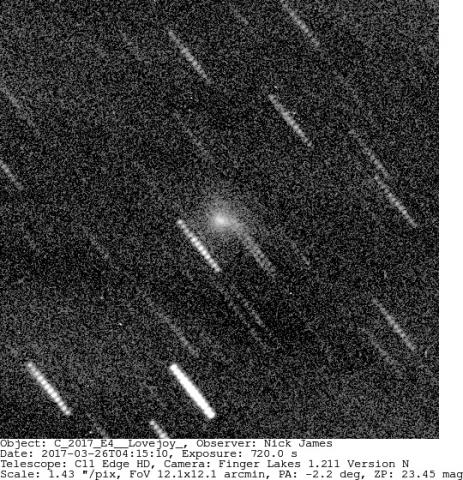
 Nick JamesParticipant
Nick JamesParticipantChris,
Your image has gone AWOL. I had cirrus problems too but it has just cleared although the seeing is dreadful. Here’s a single frame from my video taken about 30 mins ago.
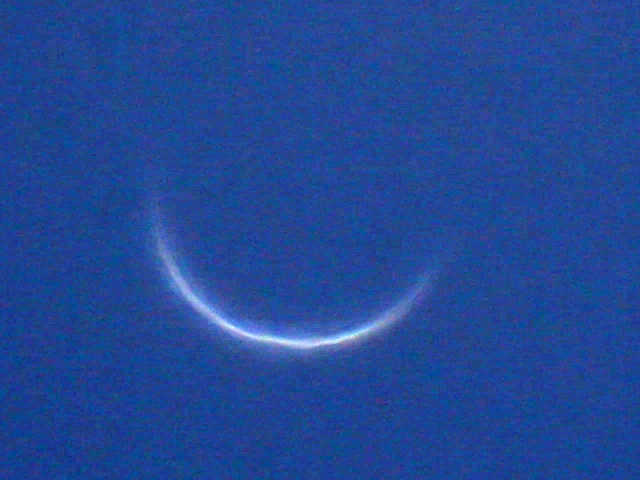
 Nick JamesParticipant
Nick JamesParticipantVery nice image! I’ve just been looking at it visually here but it is very difficult since there is a lot of cirrus around, most of which seems to have come from aircraft contrails.
 Nick JamesParticipant
Nick JamesParticipantNice images. Being the Comet Section director you’d think I would know what I was doing when it comes to observing comets but I’m not so sure. I’d made a reservation on one of the iTelescope scopes to get the M108 conjunction and was surprised at lunchtime that I hadn’t received any notification that an image was waiting. On investigation this was becuase I’d made the reservation for tomorrow! Damned timezones…
 Nick JamesParticipant
Nick JamesParticipantVenus is now a very thin crescent only 11 degrees from the Sun. It reaches its closest angular distance on Saturday when it will be 8 degrees away. This is a video from this afternoon in windy conditions. Don’t try this unless you really know what you are doing. Pointing a telescope anywhere near the Sun can be very dangerous. The picture is a single still from the video. At some point I need to put this through Registax.
The video was shot with a Canon 550D in 640×480 centre crop video mode using a Celestron 6 with a x2 Barlow.
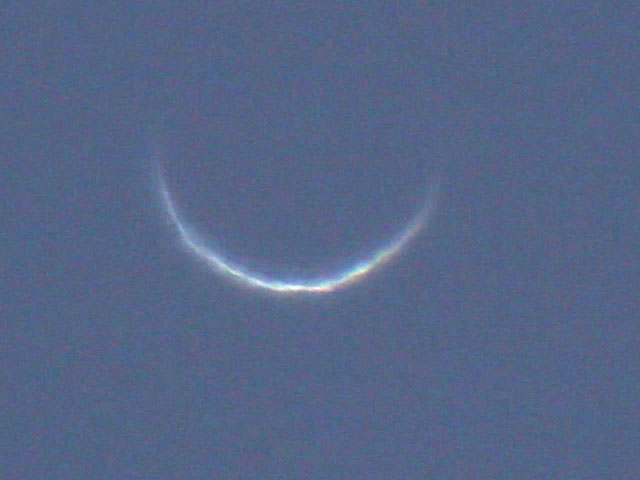
 Nick JamesParticipant
Nick JamesParticipantNice image. It really is great fun following Venus at this point in its orbit. From our latitude Venus is almost directly above the Sun at sunset now so the horns of the crescent are pointing upwards. Your image is also a great demonstration of atmospheric dispersion with blue light being refracted upwards more than red. I’m hoping we’ll get some more clear opportunities over the next few days.
 Nick JamesParticipant
Nick JamesParticipantMPEC 2017-E86 confirms this object as C/2017 E4 (Lovejoy).
 Nick JamesParticipant
Nick JamesParticipantWith the latest astrometry the ephemeris positions should be reasonably good now. This comet is coming north rapidly but the elongation is also decreasing. According to the current astrometry it crosses the equator northbound on March 28 moving through Equuleus in the morning sky.
 Nick JamesParticipant
Nick JamesParticipantWell done for getting on to Terry’s latest so quickly. It looks like it is heading for perihelion sometime around April 23rd.
Orbital elements: TJL006
Perihelion 2017 Apr 23.983223 +/- 0.434 TT = 23:35:50 (JD 2457867.483223)
Epoch 2017 Mar 12.0 TT = JDT 2457824.5 Earth MOID: 0.0106 Find_Orb
M 359.08845 +/- 0.6
n 0.02120705 +/- 0.0207 Peri. 88.82430 +/- 1.1
a 12.9265452 +/- 8.4 Node 222.71050 +/- 0.34
e 0.9622537 +/- 0.0245 Incl. 87.87017 +/- 0.10
P 46.48 H 14.7 G 0.15 U 10.1
q 0.48792827 +/- 0.00425 Q 25.3651622 +/- 71.1
From 88 observations 2017 Mar. 9-12; mean residual 0″.70 Nick JamesParticipant
Nick JamesParticipantWhile you are waiting for the post here is a scan of one of the more recent ones (from Feb 2001). Lots of familiar names.
 Nick JamesParticipant
Nick JamesParticipantNick. Sorry you can’t make it but you’ve got a good excuse. We certainly hope to release a video of the talks and I’d be happy to come on Cometwatch to discuss.
 Nick JamesParticipant
Nick JamesParticipantNice image of a challenging object. It really is zipping north now but the weather, at least in the southeast, doesn’t seem to be in a cooperative mood.
 Nick JamesParticipant
Nick JamesParticipantThought you would be out this morning for this one! It is very diffuse and surprisingly difficult at the moment.
 Nick JamesParticipant
Nick JamesParticipantBut strangely not in the meeting list on the website…
 Nick JamesParticipant
Nick JamesParticipantSteve – at least that shows that it is possible to get this comet even with very simple equipment. I’ve reprocessed my tracked image of Dec 28 using some more subframes and decent flats and attach it here. This comet is certainly living up to expectations. Although it is still difficult from the UK it is worth searching out. From London tomorrow (Jan 5) it is around 7.5 deg above the SW horizon at around 1730 when the sun is 12 deg down.
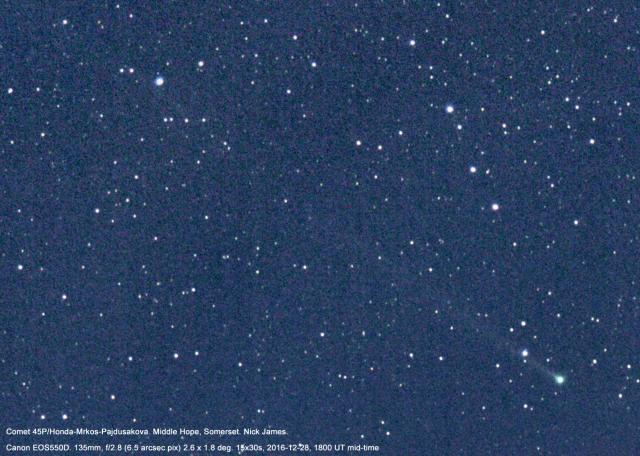
 Nick JamesParticipant
Nick JamesParticipantExcellent images Tony. This is turning out to be a really nice comet.
 Nick JamesParticipant
Nick JamesParticipantIt may not match the wonderful images taken from further south but 45P is definitely available from the UK if you have a decent horizon. Here is my image taken from Middle Hope, Somerset, tonight. It was a glorious clear sunset so I climbed to the top of this headland in the Bristol Channel and set up my Canon 550D and Star Adventurer mount. The sky finally got dark enough around 1800 UT when the comet was around 5 deg above a sea horizon. If you use your imagination the comet has a tail of rather more than half a degree in the image.
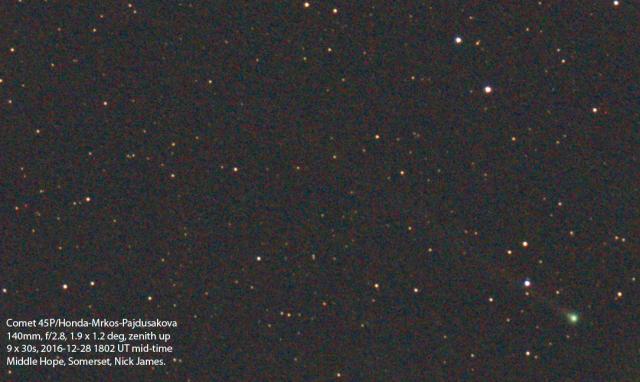
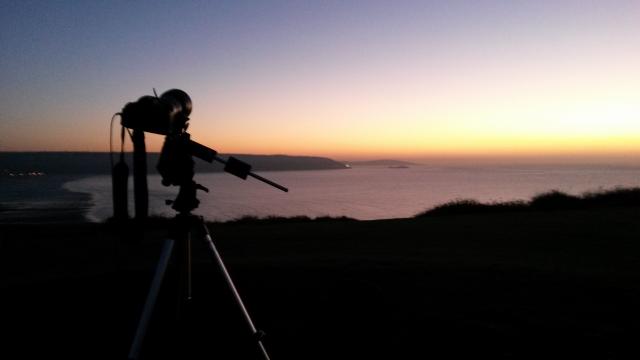
 Nick JamesParticipant
Nick JamesParticipantGerald Rhemann’s latest image of this comet is here. This was taken from the very dark skies of Farm Tivoli, Namibia with the comet around 13 degress above the western horizon, just before astronomical twilight ended. I haven’t seen any images or visual reports from the UK yet but the comet is a very difficult target in the twilight. From southern England at 17:15 UT tonight the Sun is 12 degrees below the horizon and the comet is only 8 deg up, to the right of Venus and about half the altitude. If you have a clear western horizon it’s worth trying some DSLR shots to see if you can pick this comet up at around 8th magnitude.
 Nick JamesParticipant
Nick JamesParticipantMartin’s description of the prospects for this comet is here. It will certainly be a challenge to observe it from the UK in early January but it will be a popular target for remote scopes.
 Nick JamesParticipant
Nick JamesParticipantThanks Paul. And Happy Xmas from the Director of the Comet Section too. Let’s hope for clear skies and lots of comets in 2017.
-
AuthorPosts
